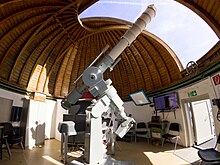Coronograph

Coronographer at the Wendelstein Observatory
The coronographer , engl. Coronagraph , was developed around 1930 by the French astronomer Bernard Ferdinand Lyot and is an astronomical instrument for observing the solar atmosphere , especially the inner corona . It consists of a telescope and special devices for dampening the sunlight.
Since the brightness of the solar corona is about a million times less than that of the photosphere , the outshining sunlight must be blocked out. This is done using a cone screen and special filters, creating a kind of artificial solar eclipse .
Coronographs are also used to observe the surroundings of bright stars, for example the planet Fomalhaut b in the vicinity of Fomalhaut , or to observe the galaxy around a quasar , as in 3C 273 .
literature
- Dennis L. Gallagher, Roger W. Sinnott: How to build a coronagraph . Sky Publishing, Cambridge Mass. 1985, ( Sky & telescope ISSN 0037-6604 , Vol. 70, No. 6).